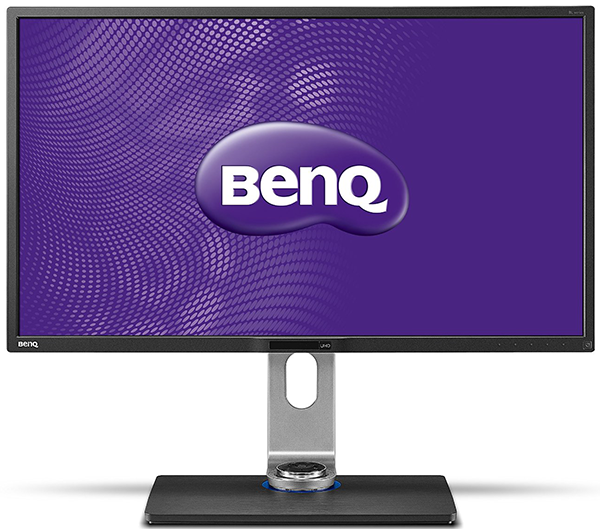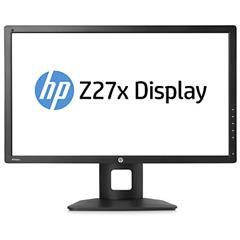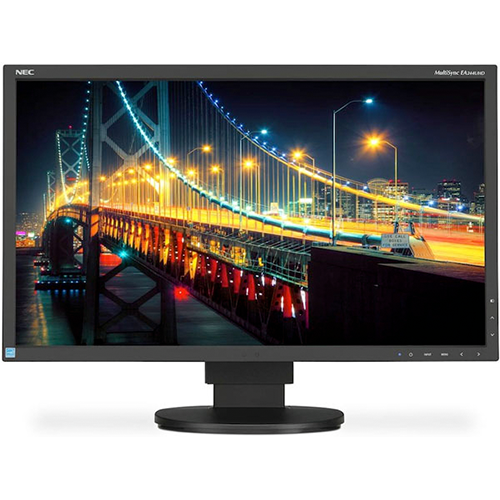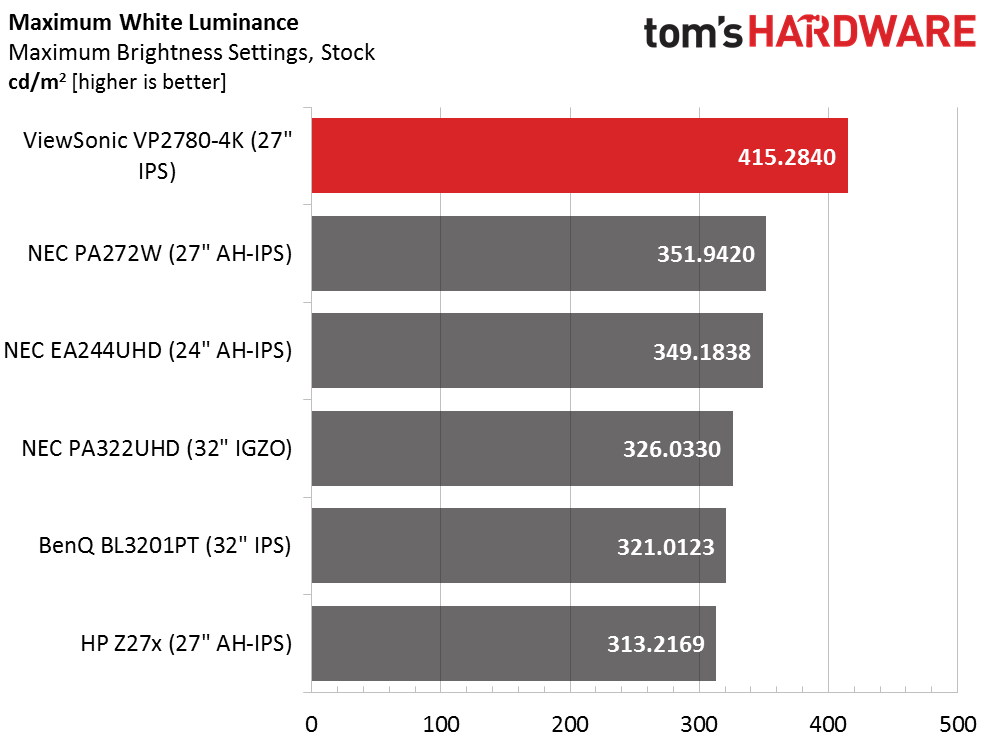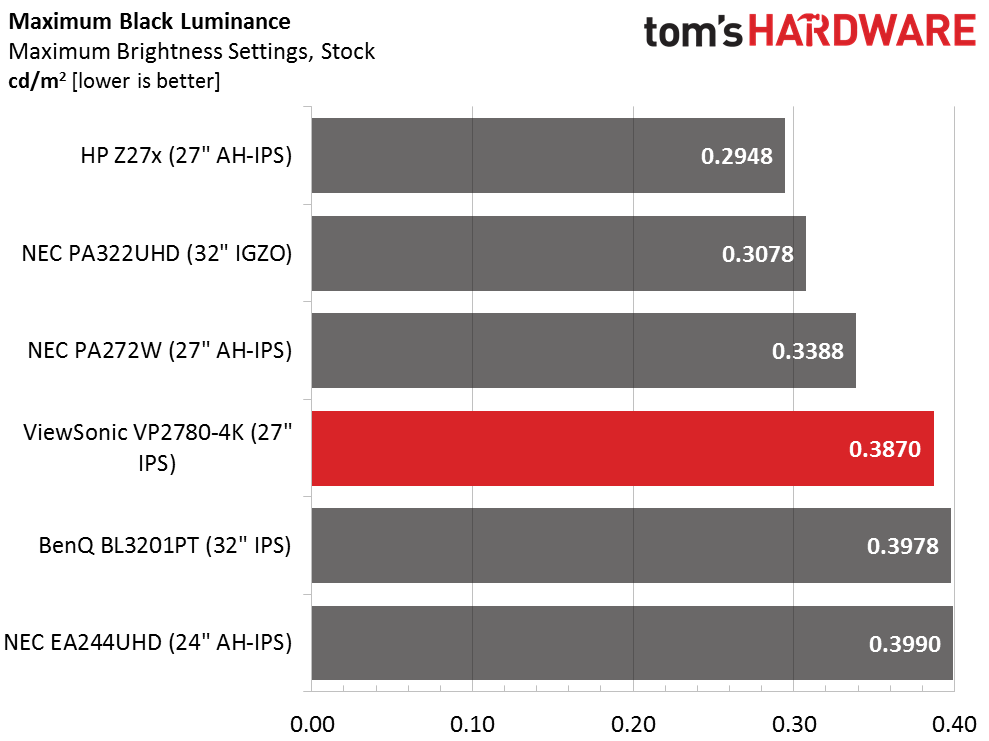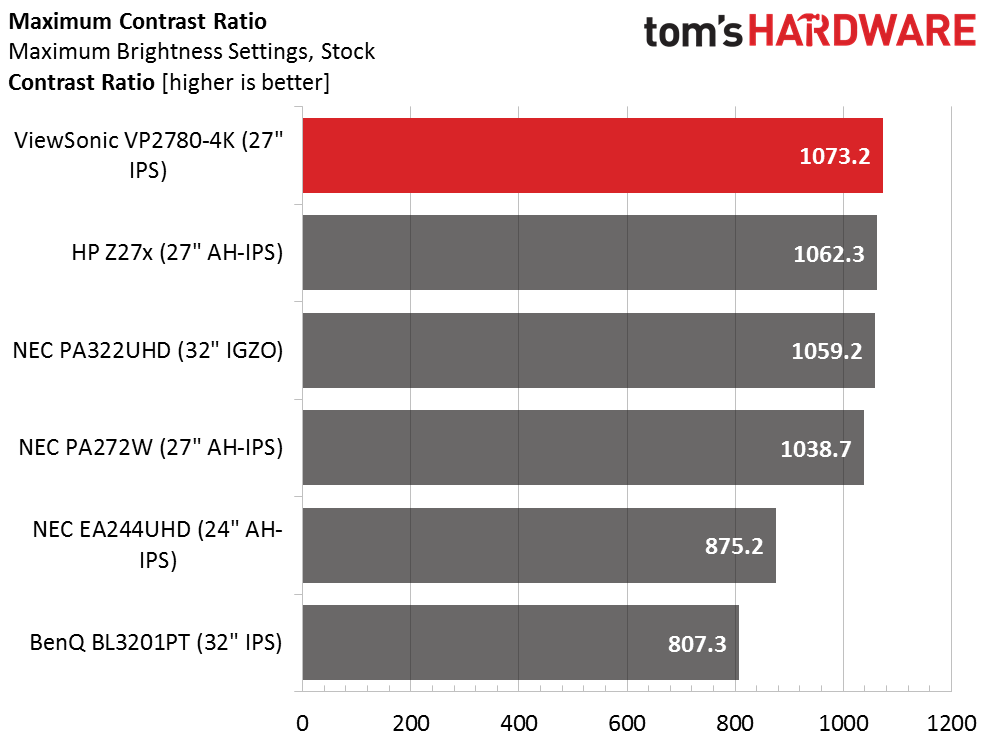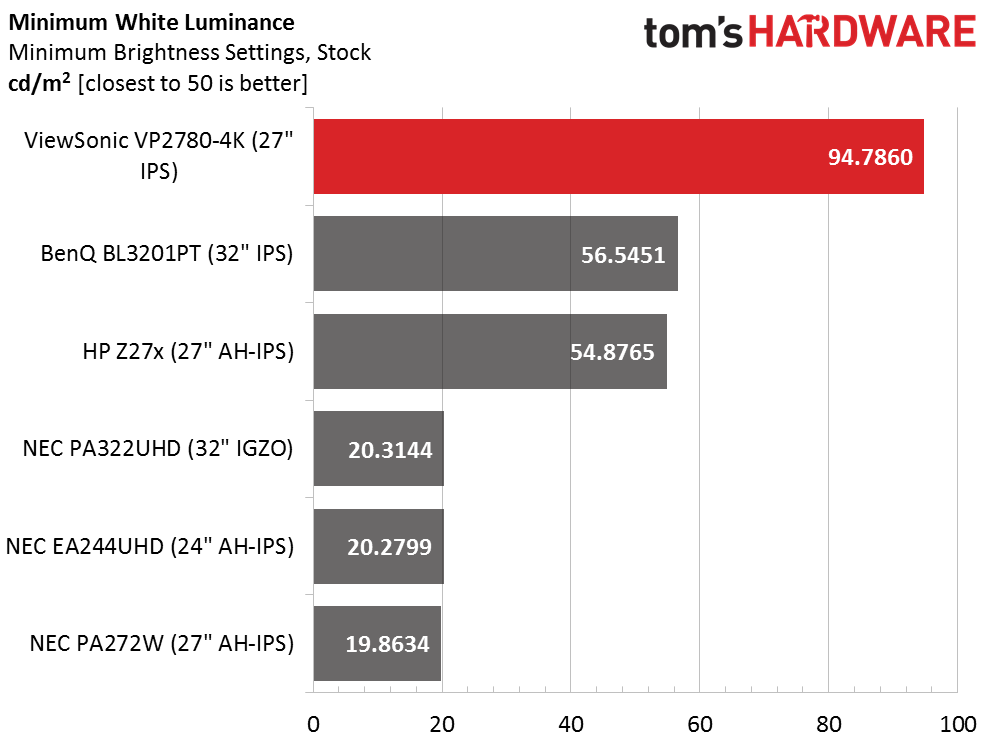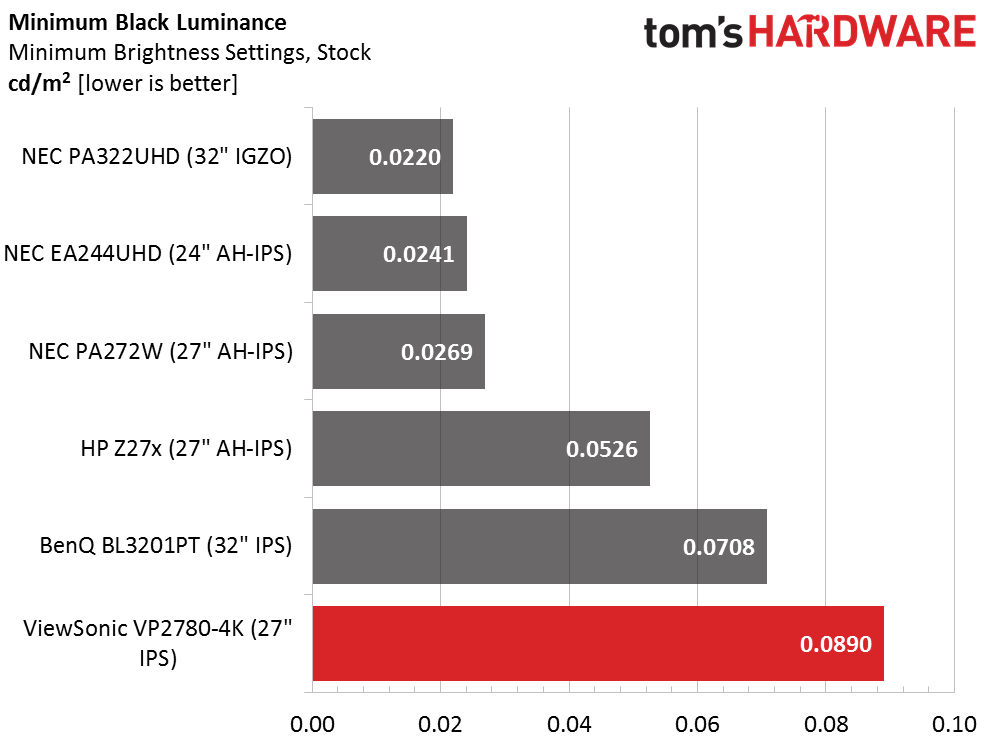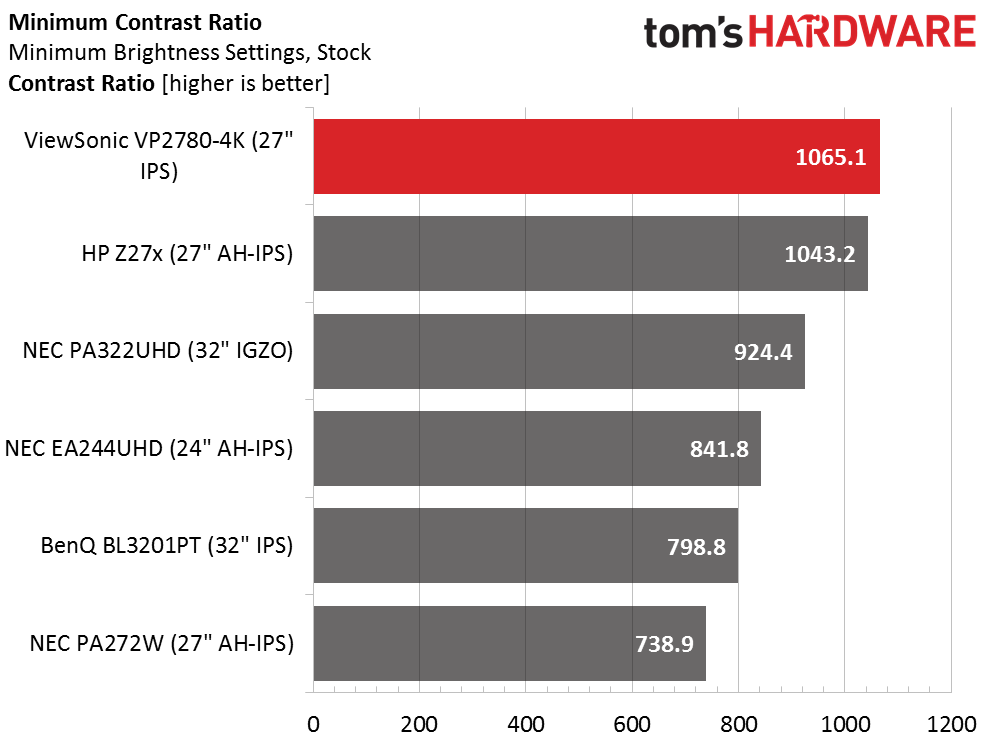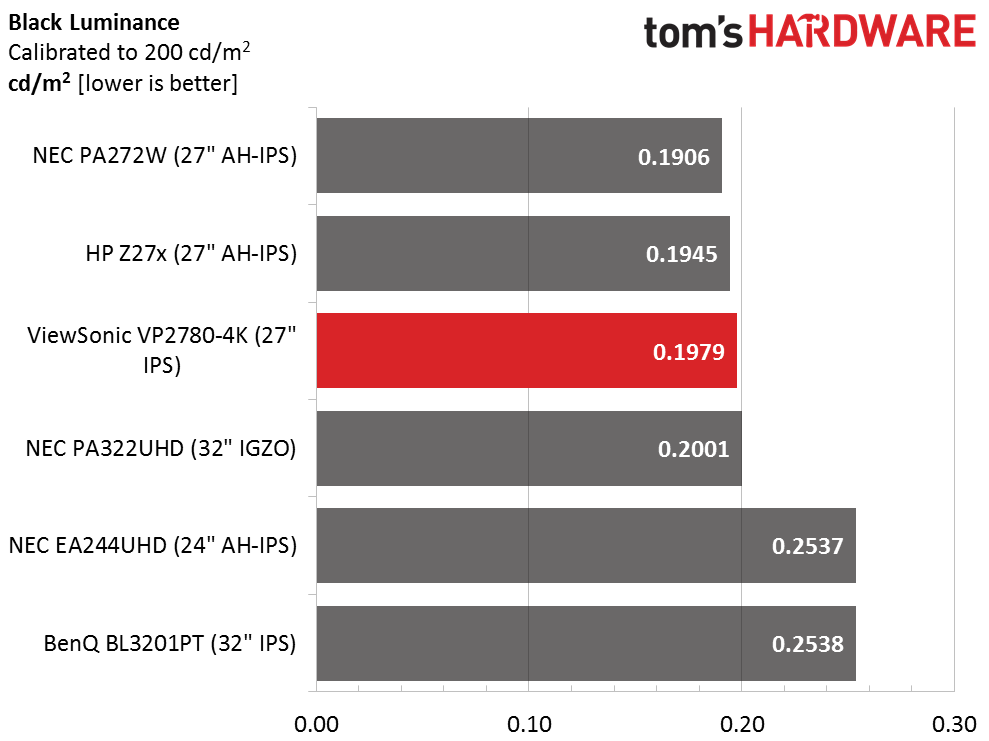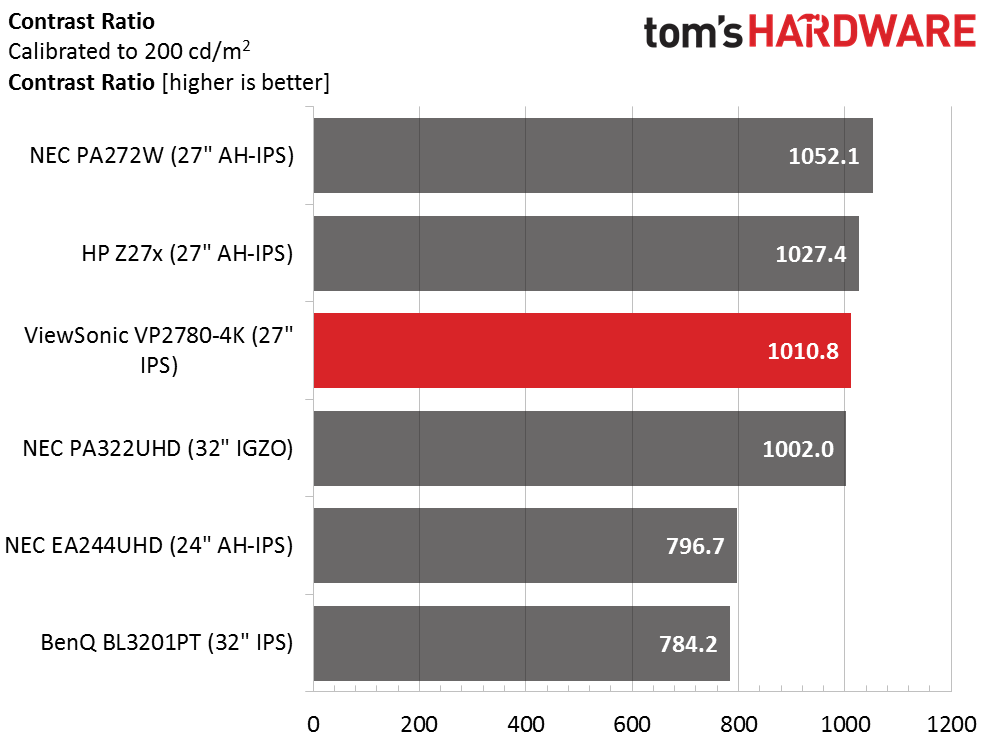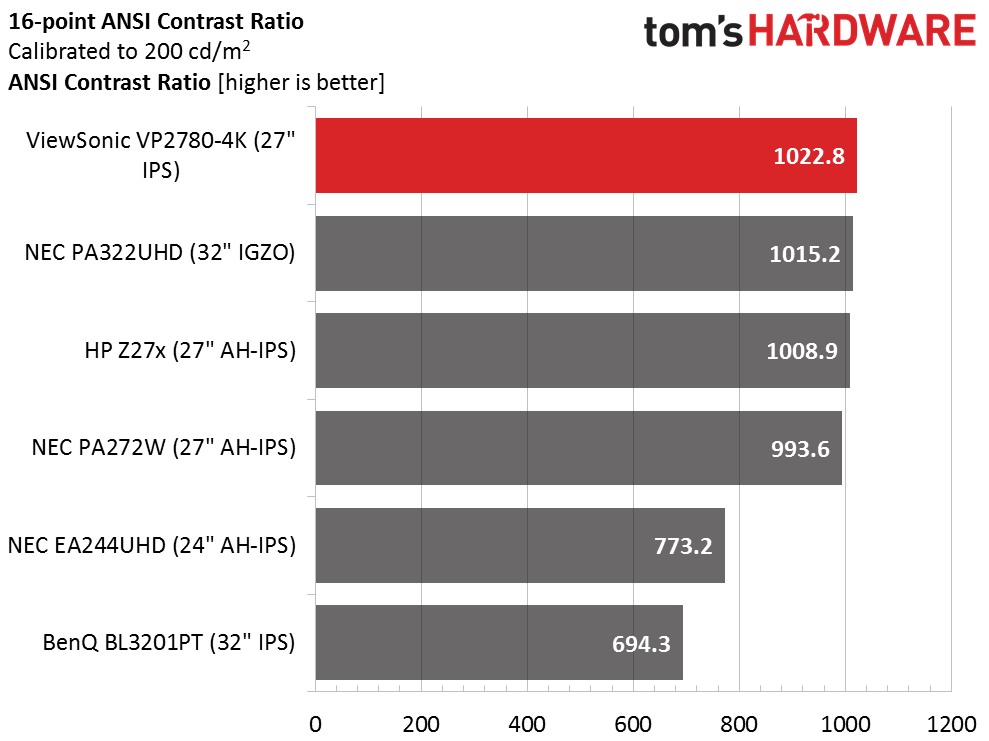ViewSonic VP2780-4K 27-inch Ultra HD Monitor Review
We've got ViewSonic's VP2780-4K in the lab today. Is this 27-inch, Ultra HD, IPS-based monitor worth your hard-earned money? Let's find out!
Why you can trust Tom's Hardware
Brightness And Contrast
To read about our monitor tests in-depth, please check out Display Testing Explained: How We Test Monitors and TVs. Brightness and Contrast testing is covered on page two.
The VP2780-4K is a pro screen in every way other than its lack of an Adobe RGB gamut option. Today we’re stacking it up against five other very accurate displays. From NEC we have the PA322UHD, PA272W and EA244UHD. Also in the group is BenQ’s BL3201PT and HP’s Z27x.
Uncalibrated – Maximum Backlight Level
ViewSonic rates the VP2780-4K at 350cd/m2 but our sample measured over 415. This is more than enough output for any task, including use outdoors. We appreciate bright monitors, but in this case the tradeoff is a high minimum backlight level — we’ll explain below.
Despite a super-bright backlight, the maximum black level is a respectable .3870cd/m2. That means this ViewSonic should post excellent contrast numbers…
… and it does. The top four screens are extremely close, but the ViewSonic squeaks out the victory. Any monitor that can boast over 1000:1 contrast is a winner in our opinion. Until VA panels are more common, IPS and IGZO are among the best.
Uncalibrated – Minimum Backlight Level
This is where some pro-users may have an issue. Many prefer a working output of 80cd/m2 and the VP2780-4K can’t quite get to that level. Granted 94.7860cd/m2 is pretty close to that. Of course our minimum benchmark is 50cd/m2, which is met by the BenQ and HP displays.
The ViewSonic finishes last in the minimum black level test thanks to its bright backlight. Luckily this doesn’t mean a drop in contrast.
Get Tom's Hardware's best news and in-depth reviews, straight to your inbox.
As you can see, it maintains its dominance with an excellent 1065.1:1 result. The VP2780-4K’s backlight covers an extremely wide range and maintains consistent contrast throughout.
After Calibration To 200cd/m2
The calibrated numbers come with a caveat: they aren’t from the VP2780-4K’s most accurate picture mode, sRGB. We are showing you the numbers from the display’s User mode instead because it’s the only one that offers a white balance adjustment. We’ll explain more on the next page. That said, a third-place black level finish isn’t a bad thing considering how close it is to the top score.
Calibrating the RGB sliders results in a small six percent drop in contrast. This isn’t much at all, but as you’ll see later, the sRGB mode is where you’ll be using the monitor most often.
ANSI Contrast Ratio
We applaud any display that can exceed 1000:1 for ANSI contrast (our most difficult test). This indicates a very high quality panel with excellent uniformity and no light-bleed. It also means the grid-polarizer layer is top-notch, which helps with detail-rendering and intra-image contrast.
Current page: Brightness And Contrast
Prev Page OSD Setup And Calibration Next Page Grayscale Tracking And Gamma Response
Christian Eberle is a Contributing Editor for Tom's Hardware US. He's a veteran reviewer of A/V equipment, specializing in monitors. Christian began his obsession with tech when he built his first PC in 1991, a 286 running DOS 3.0 at a blazing 12MHz. In 2006, he undertook training from the Imaging Science Foundation in video calibration and testing and thus started a passion for precise imaging that persists to this day. He is also a professional musician with a degree from the New England Conservatory as a classical bassoonist which he used to good effect as a performer with the West Point Army Band from 1987 to 2013. He enjoys watching movies and listening to high-end audio in his custom-built home theater and can be seen riding trails near his home on a race-ready ICE VTX recumbent trike. Christian enjoys the endless summer in Florida where he lives with his wife and Chihuahua and plays with orchestras around the state.
-
Daniel Ladishew I keep seeing prices quoted in your reviews that are lower than the links provided in the same article. This is very misleading and frankly confusing when trying to align your evaluation with the prospect of a purchase. Maybe it's time to review your system of automatic price linking and/or including how much a product costs in the text of your articles? While I don't expect it to match on the penny every time, several hundred dollar swings makes for a hard sell when you claim "a very reasonable $890 MSRP" for a product showing for over $1000.Reply -
tomc100 4K displays should start at 40" to really take advantage of the increased resolution. 27" doesn't make any sense.Reply -
Walter Smith And yet be sure we will soon be seeing 4k resolution being common in our 5" or 6" screen smartphones. As an all purpose, everyday main monitor, at this price point, this screen bears some serious consideration.Reply -
FritzEiv ReplyI keep seeing prices quoted in your reviews that are lower than the links provided in the same article. This is very misleading and frankly confusing when trying to align your evaluation with the prospect of a purchase. Maybe it's time to review your system of automatic price linking and/or including how much a product costs in the text of your articles? While I don't expect it to match on the penny every time, several hundred dollar swings makes for a hard sell when you claim "a very reasonable $890 MSRP" for a product showing for over $1000.
Thanks for the input. In many articles we do call out the fact that the prices in the article are based on the writing time frame. I'll make a note about getting better and more consistent at that. The "buy buttons" we place into the articles, which are linked from e-tailers/merchants are typically dynamically linked using APIs. So the prices in those buttons are supposed to represent real time pricing, which, as you know, fluctuate madly depending on the category. The upside is that we'll always have the latest pricing. The downside is that it's different than what we put into our written text, and sometimes how we determine our "value" analysis, where applicable. Another downside is that sometimes the API implementations are a little wonky, a situation our development and commerce teams are continually trying to address.
- Fritz Nelson, Editor-in-chief
-
zcat Do all of these 4k monitors do decent 1080p upscaling? That's my only real concern, since nobody's going to be gaming @ 4k native for quite a while, so the upscaling should look good and have negligible impact.Reply -
Brian_R170 I really like this monitor, but fear Viewsonic's reliability. In 2008-2009, my work group bought a few hundred value-priced 27-inch Viewsonic monitors and 23-inch Viewsonic TVs. The failure rate was unbelievably high, easily surpassing 50% in the first year for the 27-inch model. The 23-inch TVs fared better, but surpassed 50% failure within 3 years. Viewsonic replaced the ones that failed under warranty with refurbs, and they failed, too.Reply
I personally bought one of the same 27-inch models from Costco for home use after using one at work, it failed in less than 3 months. Thank goodness for Costco's warranty.
Maybe just really bad quality control on a couple of low-end models, but it scares me when the author writes "The obvious question has to be: what’s missing?", because in my past experience, what was missing was quality control. -
InvalidError Reply
Tell that to people who choose to do most of their reading on 1200-1600p 7-10" tablets due to the more pleasant, crisper, more paper-like fonts. I wouldn't mind having a 24-27" UHD display for reading. I am still a big fan of dead-tree format for reading because crisper fonts and higher contrast reduce eyestrain.16167997 said:4K displays should start at 40" to really take advantage of the increased resolution. 27" doesn't make any sense. -
-Fran- Looks like a solid option. I miss my low latency Viewsonics from old, but Samsung gave fierce competition. I wonder what Samsung will bring to the table now.Reply
And please make prices go down already. I want one of these puppies at a reasonable 300-ish price, haha.
Cheers!
